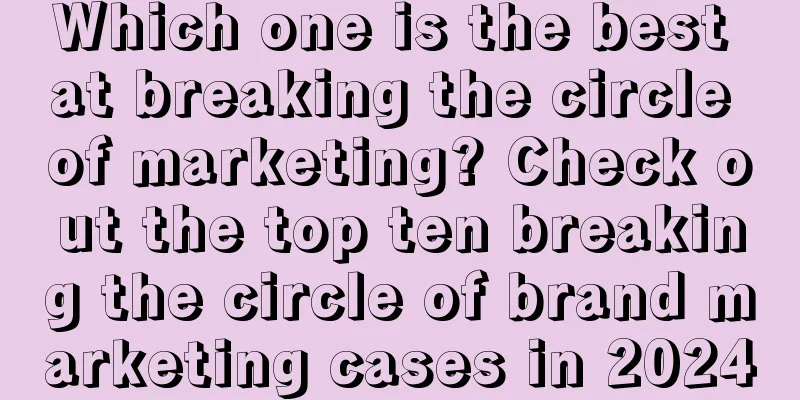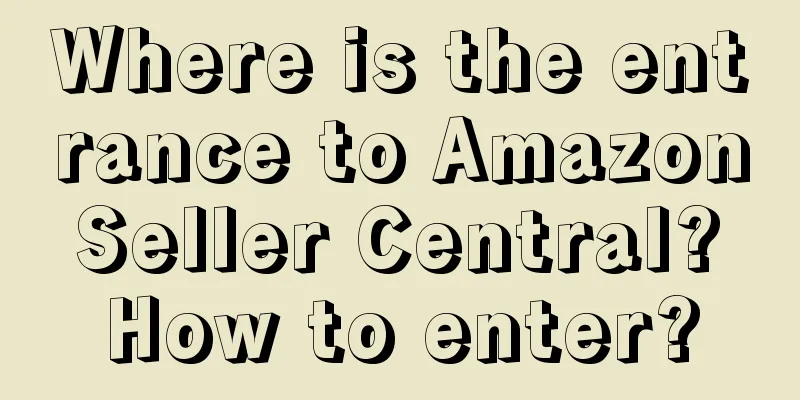What problems can “closed-loop thinking” solve in corporate marketing?

Last weekend, I attended an interesting gathering of Shanghai writers, where we had in-depth exchanges on the business model of book monetization. What impressed me was that the senior writers all mentioned the concept of "closed-loop thinking". I have long applied "closed-loop thinking" to my daily digital marketing work practice. In my new book "Global Growth", I also use "three closed loops" as the key link of the 1+2+3+4 pyramid methodology. So what is closed-loop thinking? Why is "closed-loop thinking" so important in marketing work? And how can we apply "closed-loop thinking" to our daily work? In his best-selling book "The Fifth Discipline", Peter Senge mainly introduced the fifth discipline of "systems thinking". The system thinking method has three basic elements: continuously reinforcing feedback, repeatedly adjusted feedback, and time lag. Its ever-increasing feedback actually strengthens the closed-loop theory, which has many case applications in corporate management. The "Matthew effect" in economics and the "compound interest effect" in finance are both the results and phenomena of the use of "closed-loop thinking" . For example, when a person accomplishes many things and achieves certain achievements, he obtains positive feedback from the outside world, and his self-energy continues to increase. He then accepts more challenges and accomplishes more things, and his energy becomes stronger and stronger. This is a person's closed loop of success. For example, an author can build a set of innovative methodologies in a certain field in a book and gain recognition. Through the book and the methodology, he can build a personal brand, attract customer resources through the personal brand, or have more opportunities to succeed in business practice through his methodology. The success of business practice helps him to bring stronger personal brand influence. This is a closed loop of personal brand, methodology and business practice. So how do we understand and practice "closed-loop thinking" in marketing? My new book "Global Growth" specifically explains three aspects: 1. Public-private-public channels and traffic closed loopOpen the marketing funnel in the public domain, obtain large traffic, and reach a wide range of people on a large scale. Then, accumulate user data in the private domain, incubate leads, operate users, and accumulate private domain user data. User insights help brand owners find their defined target groups more accurately in the public domain, improve user reach efficiency, and reduce accurate reach costs. In this process, brand data and accumulated private domain user insights play a key role. From the public domain to the private domain and back to the public domain, by breaking the boundaries between online and offline, public and private domains through marketing activities at decentralized consumer touchpoints, the company's omni-domain marketing methods are iterated to form a "consumer- and customer-centric" full-link and omni-channel marketing closed loop, which is about the closed loop of channels and traffic. 2. Marketing Management Closed LoopIf the channel and traffic closed loop from public domain to private domain and then to public domain is more for external consumers and target customers, then the closed-loop thinking of marketing management is a requirement for marketing managers, which refers to following the closed loop from planning, implementation, inspection to processing, that is, the PDCA (plan-do-check-act) cycle. As part of my daily work in the company, marketing based on the WeChat ecosystem is an important part of my work. I have fully implemented the closed-loop thinking model of marketing management and achieved exponential growth in new customer conversion. How do I do it specifically? At the end of the year, we formulate a WeChat ecosystem marketing plan for the second year and list the work priorities based on the marketing goals, such as increasing the conversion rate by XX% and increasing the number of qualified sales leads in the market by 10%. On this basis, growth factors are formulated, such as brand marketing activities with the theme of sustainable development, improving user experience, adding keyword automatic reply functions and customer self-service sections to identify customer needs and provide corresponding services in the first time, optimizing information retention forms, and conducting refined operations for customers according to industry, etc. as core strategies. Then let’s look at how SCRM (social CRM) automated marketing tools can help achieve the above goals and strategies. This is the application of marketing tools based on specific business scenarios and business needs. It is also the key link in execution and the embodiment of the core value of marketing tools. During this process, you need to focus on details, and look at marketing data every week or even every day, such as changes in retention volume and changes in marketing funnel conversion rates. Based on this, you can continuously adjust the execution means and methods corresponding to the above strategies, and quickly find ideas and take action through team brainstorming. Practical experience tells me that the implementation of marketing strategies and marketing effects are constantly iterating and improving in the marketing management process of practicing "closed-loop thinking", which not only improves the return on investment, but also creates golden cases and gains influence. On this basis, general methods are summarized, which can be copied to other business units with similar business models, achieving three goals with one stone. 3. Data closed loopWhether it is the products and services provided, the content produced, or the experience given to consumers, these are all external, visible marketing elements, but they are just the tip of the iceberg. Underneath all these visible elements is "data", the "invisible hand". The typical feature of a closed data loop is that data drives marketing decisions, which is reflected in the following aspects: 1. Closed loop of content and data:A large amount of data is generated through the production and distribution of different forms such as short videos, press releases, WeChat tweets, advertising content, etc., such as content clicks, consumer and content interaction data, which users viewed which content, which content is more popular with which type of consumers, etc., to help brand owners better understand users. These data constitute an important part of user insights. The core is to help brand owners use this data to produce higher-quality content to better achieve their marketing goals, and more and better-quality content produces higher-quality data. The cycle is repeated, and content and data are constantly optimized in the process. This is a closed loop about content and data. 2. Closed loop of product development, data and user insights:In the Internet age, it is easy for users to leave comments about products or services provided by companies on social media platforms. These data constitute key insights into users' product needs and feedback. Companies use this data to better understand customer needs, thereby developing products that are more in line with consumer needs and achieving higher sales and profit growth. Products that are closer to the market will generate more new customers who will buy the products and loyal customers. These customers are not afraid to speak out on various social media platforms and even participate in the early evaluation of corporate product development, thereby generating more user insight data to help companies better develop products. This is a closed loop of products, data and user insights. There are actually many applications of data in the field of marketing , such as tracing the acquisition of new users and sales, selecting media channels for user reach, personalized marketing based on user classification, establishing a user tag system, building a user scoring model, etc. These key means of marketing are all driven by data. Without data, all these means will lose their support and cannot be executed. One of the biggest challenges in an enterprise is the issue of data quality. Data quality is directly related to whether these marketing methods can be effective. Methods are ultimately just methods, and data quality is the foundation. Without this foundation, high-rise buildings can never be built. To summarize the views in this article: I mentioned three closed-loop thinking in marketing:
For enterprises, data assets have become the most critical assets in the digital age. From now on, accumulating data, sedimenting data assets, and applying closed-loop thinking to better utilize data for marketing services will be the winning strategy for the next decade and the moat for establishing differentiated competitive advantages. Author: Zhu Jingyu Source: WeChat official account "Jade Digital Marketing (ID: Jade_Digital)" |
<<: The content industry is undergoing a major change. Are all the hits dependent on AI?
>>: My observations on the recent developments of WeChat Video Account
Recommend
Which Shopee site has the highest profit? Analysis of each site
The Shopee platform is very popular. There are man...
What is the Amazon customer service phone number? How can I reduce the response time?
Amazon has a large number of consumers from many c...
What is Amazon's lead time? How do I update the default lead time?
For Amazon sellers, it is a very happy thing to ha...
The i people and e people are not over yet, why are the strong people and the weak people starting again?
After i-people and e-people, new personality categ...
Why don’t some companies tell stories?
In the business world, the ability to tell stories...
Why don’t I want to do cross-border e-commerce anymore after working in it for half a month?
As an emerging trade model, cross-border e-commerc...
What do I need to open a store on Amazon US?
Amazon has many sites. If you want to choose one o...
When eating barbecue, I saw the doubts of old brands
In the new era, users have changed, and their need...
SaaS Customer Lifecycle and Operation Methods (Part 2)
In the SaaS Customer Lifecycle and Operation Metho...
The current brand competition is no longer a competition of minds, but a competition of narratives!
In today's commercial competition, the traditi...
Content e-commerce: Douyin, Kuaishou, and Xiaohongshu "part ways"
As content platforms move into the e-commerce fiel...
What is the difference between eBay China and Taobao? A must-read for cross-border merchants
eBay China and Taobao are two very well-known plat...
The business rule in the era of consumer tightening: Don’t sell “things”, sell “things”.
The reason why Japan's 7-Eleven convenience st...
Find the right target audience, these 8 questions can help you avoid detours!
When writing copy, do you not know who your target...
What are the advantages and disadvantages of Amazon Global Shopping?
There are many cross-border e-commerce platforms, ...









